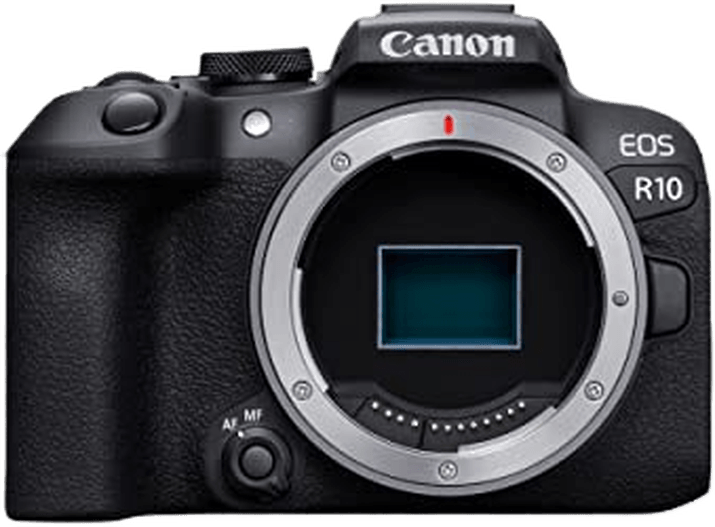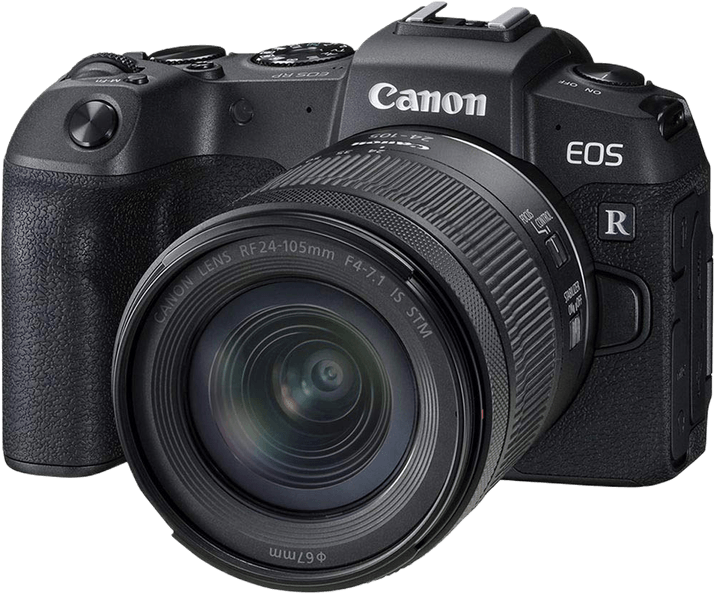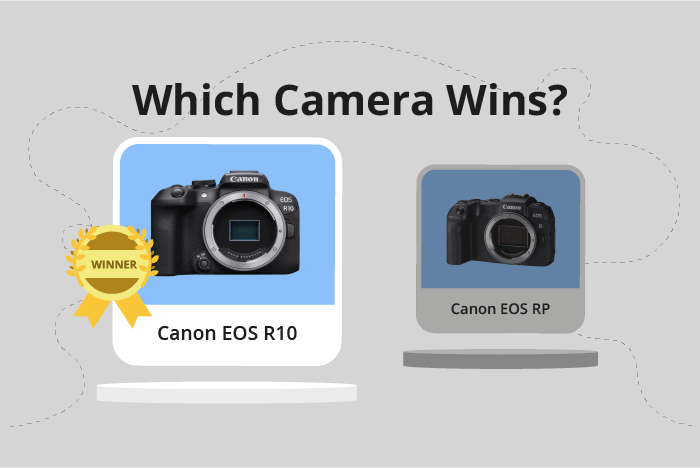Canon EOS R10 vs EOS RP Comparison
Canon EOS R10

Canon EOS RP

The Canon EOS R10 outperforms the Canon EOS RP with a score of 69/100 versus 65/100. Both cameras are mirrorless and share similar dimensions, with the R10 being slightly smaller at 123 x 88 x 83mm compared to the RP’s 133 x 85 x 70mm. The R10 also has a lighter weight of 426g, while the RP weighs 440g.
The R10’s advantages include its more recent release in 2022 and its lower launch price of $980 compared to the RP’s release in 2019 and a launch price of $1300. This means that the R10 offers better value for money and likely has more up-to-date features.
On the other hand, the RP’s only advantage is its slightly slimmer depth, which makes it a bit more compact. However, this advantage is minimal compared to the R10’s benefits.
Considering the superior score, lower price, and more recent release, the Canon EOS R10 is the better choice between these two cameras. The Canon EOS RP, although more compact, falls short in terms of overall value and performance.
Canon EOS R10 vs EOS RP Overview and Optics
The Canon EOS R10 wins the optics comparison with a score of 71/100, while the Canon EOS RP scores 67/100. Both cameras share common specifications, including a CMOS sensor, Canon RF lens mount, and lack of image stabilization. However, there are differences that contribute to the R10’s higher score and make it the better camera in terms of optics.
The EOS R10 has a shooting speed of 15, significantly faster than the RP’s 5, allowing it to capture more images in a shorter time. Additionally, the R10 features a more advanced Digic X processor, which improves image processing speed and overall performance compared to the RP’s Digic 8 processor. Furthermore, the R10’s sensor has a higher DXOMARK score of 97, indicating better image quality than the RP’s 85.
While the EOS RP has a higher megapixel count of 26 compared to the R10’s 24, the difference is minimal and may not result in a noticeable improvement in image quality. The RP’s main advantage is its full-frame sensor size, which provides better low-light performance and a wider field of view than the R10’s APS-C sensor. However, this benefit is outweighed by the other advantages the R10 holds in shooting speed, processor, and sensor quality.
In comparing the optics of the Canon EOS R10 and EOS RP, the R10 emerges as the superior camera due to its faster shooting speed, advanced processor, and higher sensor quality. The RP’s higher megapixel count and full-frame sensor are not enough to surpass the R10’s overall performance. Thus, the Canon EOS R10 is the better choice for those prioritizing optics in their camera selection.
Canon EOS R10 vs EOS RP Video Performance
The Canon EOS R10 outperforms the Canon EOS RP in video capabilities, scoring 91/100 compared to the EOS RP’s 70/100. Both cameras share some common specifications, such as 4K max video resolution, 3840 x 2160 max video dimensions, and built-in time-lapse functionality. However, there are significant differences that make the EOS R10 a superior choice for videographers.
The EOS R10 boasts a higher max video frame rate at 120fps, compared to the EOS RP’s 25fps. This allows the R10 to capture smoother, more detailed slow-motion footage, providing superior creative options for filmmakers. The increased frame rate means that the R10 can record fast-paced action scenes with better clarity and precision, making it a more versatile choice for professional video projects.
While the EOS RP shares the same 4K resolution and time-lapse functionality, its lower frame rate limits its video performance in comparison to the R10. However, the EOS RP can still produce high-quality 4K footage at 25fps, which may be sufficient for casual videographers or those on a tighter budget.
Taking into account these differences, the Canon EOS R10 is the clear winner in terms of video capabilities. Its higher frame rate allows for more creative options and enhanced video quality, making it a better choice for serious videographers. On the other hand, the Canon EOS RP’s lower score does not mean it is a bad camera, but it may be more suitable for casual users or those prioritizing budget over advanced video features.
Canon EOS R10 vs EOS RP Features and Benefits
The Canon EOS R10 and Canon EOS RP both have a feature score of 70 out of 100, making them equal in this aspect. They share several common specifications, including a 3-inch screen size, 1040000-dot screen resolution, touchscreen capability, flip screen, absence of GPS, and the presence of both WIFI and Bluetooth connectivity.
Despite having the same feature score, the Canon EOS R10 offers advantages over the Canon EOS RP in certain areas. However, these advantages are not specified in the given information. It is essential to research and consider these additional features when choosing between these two cameras.
On the other hand, the Canon EOS RP also has its own strengths compared to the Canon EOS R10. Again, these strengths are not provided in the given information. Potential buyers should investigate the unique features of the Canon EOS RP and determine if they are more valuable for their specific needs.
In comparing the Canon EOS R10 and Canon EOS RP, it is crucial to analyze their shared specifications and understand the unique advantages each camera offers. By doing so, a well-informed decision can be made on which camera is the better choice for a specific individual’s photography and videography needs.
Canon EOS R10 vs EOS RP Storage and Battery
The Canon EOS R10 outperforms the Canon EOS RP in storage and battery, scoring 40/100 compared to the RP’s 29/100. Both cameras share some similarities in this category, such as having one memory card slot each and accepting SD, SDHC, and SDXC memory cards. Additionally, they both use LP-E17 batteries and offer USB charging capabilities.
The R10’s superiority lies in its battery life, providing 450 shots compared to the RP’s 250 shots. This longer battery life allows photographers to capture more images without needing to recharge or swap batteries frequently.
On the other hand, the EOS RP has a slight advantage in memory card compatibility, as it supports UHS-II cards, while the R10 only supports UHS-I cards. This means faster read and write speeds for the RP, which can be useful for photographers who require high-speed data transfer.
Taking these factors into account, the Canon EOS R10 offers a better battery life, making it more suitable for extended shooting sessions. However, the Canon EOS RP may be favored by those who prioritize faster memory card performance.
Alternatives to the Canon EOS R10 and EOS RP
Are you still undecided about which camera is right for you? Have a look at these popular comparisons that feature the Canon EOS R10 or the Canon EOS RP:

